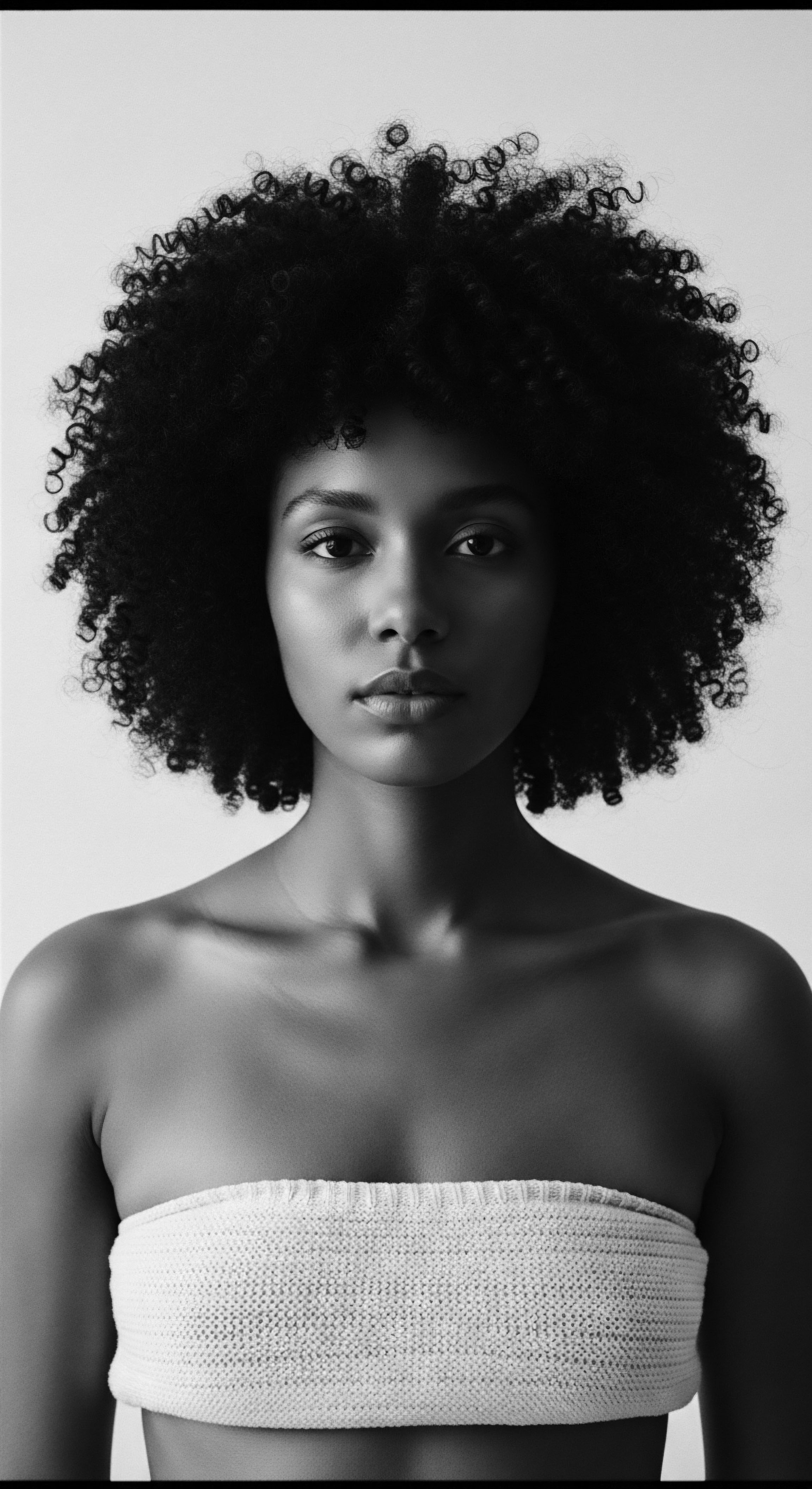
Roots
Our strands, each a spiraling testament to lineage and resilience, hold memory within their very structure. For generations, the care of textured hair has been more than a simple act of hygiene; it is a profound engagement with heritage, a whispered conversation across time. The question of whether modern science can enhance black soap’s moisture benefits for coily strands is not merely a technical inquiry.
It beckons us to consider the enduring wisdom embedded in ancestral practices and the intrinsic qualities of the hair itself. This journey into hair’s fundamental being begins with understanding the canvas—the coily strand—and the ancient cleanser that has long served its needs.

The Anatomy of Coily Strands
The unique architecture of coily hair is a subject of both ancestral observation and scientific scrutiny. Unlike hair with straighter patterns, each coily strand emerges from an elliptical or hooked follicle, causing it to spiral as it grows. This helical path creates numerous points where the hair shaft bends and twists. Such structural particularities influence how moisture interacts with the hair.
The outermost layer, the Cuticle, composed of overlapping, scale-like cells, acts as the hair’s protective shield. In coily hair, these cuticles often lift at the curves and turns, creating avenues for moisture to enter quickly. Yet, these same openings mean moisture can depart just as swiftly.
Another key factor for coily strands is the natural distribution of Sebum. The scalp produces this oil to condition and shield the hair, but its journey down a spiraling strand proves challenging, leaving the lengths and ends prone to dryness. This inherent dryness, combined with the often-raised cuticle layer, renders coily hair susceptible to breakage if not carefully tended. Understanding these intrinsic characteristics, which were implicitly observed and responded to by ancestral caregivers, forms the basis for any contemporary approach to hair health.

Black Soap’s Ancient Composition and Ancestral Purpose
African black soap, known by names like Alata Samina in Ghana or Ose Dudu among the Yoruba of Nigeria, is a testament to the ingenuity of ancestral communities. Its creation is a communal, time-honored practice, often passed from mothers to daughters over countless generations. This soap is crafted from locally harvested plant materials. Common ingredients include the ash of Plantain Skins and Cocoa Pods, combined with nourishing oils such as Palm Kernel Oil, Shea Butter, and Coconut Oil.
The ash component provides the alkalinity necessary for saponification, the chemical reaction that transforms oils into soap. While the exact pH can vary, traditional black soaps often exhibit an alkaline nature, typically around a pH of 10. This alkalinity facilitates a thorough cleanse, removing impurities and buildup from the hair and scalp.
Ancestral users recognized its deep cleansing ability, often noting its capacity to cleanse without stripping the hair entirely of its natural oils, a balance critical for coily textures. Its traditional use also extended beyond mere cleansing, acting as a restorative for skin conditions, a function linked to its natural antibacterial and antifungal properties.
The deep understanding of coily hair’s inherent need for moisture, coupled with black soap’s natural cleansing and nourishing components, grounds our historical appreciation of its ancestral efficacy.
The plantain skin, for instance, offers vitamins A and E, along with iron, contributing to its nutritional value for the scalp. Shea butter, a consistent ingredient in many formulations, is a natural emollient, providing lipids that coat and condition the hair. This blend of cleansing and conditioning properties, derived directly from the earth’s bounty, provided a holistic approach to hair care long before the advent of modern cosmetic chemistry.
| Component Plantain Skin Ash |
| Traditional Source / Function Alkaline agent for saponification, provides vitamins A and E, iron. |
| Component Cocoa Pod Ash |
| Traditional Source / Function Alkaline agent, provides antioxidants and mild exfoliation. |
| Component Shea Butter |
| Traditional Source / Function Natural emollient, deeply moisturizes and softens hair. |
| Component Palm Kernel Oil |
| Traditional Source / Function Cleansing agent, conditioner, source of fatty acids. |
| Component Camwood (Osun) |
| Traditional Source / Function Antiseptic, skin balancing, often associated with spiritual cleansing. |
| Component These components, thoughtfully combined through ancestral methods, form the foundation of black soap's enduring legacy in hair care. |

Ritual
The whispers of tradition carry the weight of care practices that have sustained coily strands through generations. Hair rituals, especially for those with textured hair, are deeply intertwined with community, identity, and the preservation of cultural heritage. Black soap, in its unadorned form, was a central element in these tender threads of care, providing not just physical cleansing but also a symbolic purification. To speak of its improvement by modern science requires a pause, a moment to acknowledge the holistic purpose it already served within ancestral frameworks.

The Tender Thread of Cleansing and Preparation
In many West African communities, the act of hair washing with black soap was a gentle ritual, often performed collectively. The soap, soft and porous, would yield a rich lather when worked with water. This lather, applied to the hair and scalp, would cleanse away impurities, excess oils, and environmental dust. The traditional formulations, rich in natural oils like shea butter and palm kernel oil, meant that even in its cleansing action, the soap imparted some moisture, helping to counter the inherent dryness of coily hair.
The traditional understanding recognized that thorough cleansing was the first step in preparing the hair for further treatment and styling. Hair was often massaged, allowing the beneficial properties of the black soap to address scalp health concerns, such as irritation or flakiness. The practice itself, a mindful engagement with the hair and scalp, contributed to a sense of wellbeing that transcended the physical. After cleansing, the hair was ready for conditioning oils or butters, meticulously worked into the strands to seal in hydration and prepare for the intricate styling that often followed.

Echoes of Resilience in Hair Narratives
The journey of textured hair care, particularly for individuals of Black and mixed-race ancestry, is a chronicle of resilience. After the transatlantic slave trade, access to ancestral herbs and traditional ingredients became severely limited for enslaved Africans in the Americas. This forced a radical adaptation in hair care. Stripped of their traditional tools and knowledge, individuals resorted to whatever was available.
Sarah Heaton notes that enslaved Africans, in their struggle for self-expression amidst collective trauma, would use materials like Soap and broken glass to sculpt symbolic shapes into their hair (Heaton, 2021). Yet, without familiar haircare essentials, maintaining coily textures was a constant battle. Products like kerosene and allegedly bacon grease were used, reflecting a desperate need for solutions, however inefficient or damaging.
This stark contrast highlights the challenge faced by generations seeking to care for their coily strands. Madam C.J. Walker, a pioneer in Black hair care, herself grappled with hair loss in the late 19th century, a condition potentially worsened by exposure to harsh lye soap and inadequate hygiene practices of the time.
Her efforts to create a hair care system for Black women, though sometimes including tools like the hot comb, represented a response to a profound need for products that acknowledged and addressed the particularities of textured hair, moving beyond the harsh realities imposed by the environment and dominant beauty standards. This era underscored the continuous adaptation and innovation within Black hair heritage, seeking ways to nurture coils even when ancestral wisdom was suppressed or materials were scarce.
- Traditional Cleansing ❉ Black soap provided a deep, yet often gentle cleanse, preparing hair for subsequent ancestral conditioning.
- Scalp Wellness ❉ Its natural properties addressed scalp issues, fostering an environment for healthy growth, a concept central to traditional hair care.
- Holistic Connection ❉ Hair cleansing was part of a broader wellness approach, linking physical care with community bonds and identity.

The Evolution of Care ❉ From Simplicity to Specificity
The simple efficacy of traditional black soap, rooted in its natural composition, provided a foundation for moisture and cleanliness. Its alkalinity helped lift the cuticle, allowing cleansing agents to work, but also meant that without subsequent conditioning, hair could feel dry. This is where the ancestral wisdom of layering—applying oils and butters after washing—came into play. These post-cleanse rituals sealed the moisture within the hair shaft, compensating for the soap’s inherent cleansing action.
The historical practices offer a blueprint. Modern science, in considering black soap, does not seek to replace this heritage but to understand its mechanisms and perhaps refine them. The goal is to build upon centuries of experiential knowledge with precise scientific understanding, ensuring that the moisture benefits, so vital for coily hair, are not only preserved but optimized, honoring the legacy of those who first harnessed nature’s bounty for hair’s vitality.

Relay
The enduring dialogue between ancestral practice and contemporary discovery leads us to a central question ❉ Can modern science refine black soap’s moisture benefits for coily strands? This inquiry invites us to witness a powerful collaboration, where the precision of scientific understanding meets the profound wisdom of heritage. The aim is not to diminish the original, but to amplify its intrinsic gifts, ensuring textured hair receives unparalleled care that is both innovative and culturally resonant.

Decoding Moisture ❉ A Scientific Lens
Coily hair’s propensity for dryness means effective moisture retention is paramount. Modern cosmetic science distinguishes between various types of moisturizing agents that could complement black soap’s cleansing action. Humectants, such as glycerin or honey (already present in some black soap variations like Dudu-Osun), draw water from the environment into the hair shaft. Their effectiveness, however, is dependent on environmental humidity; in very dry conditions, they can draw moisture out of the hair.
Emollients, including oils, butters, and fatty alcohols, work by forming a protective film on the hair surface, smoothing the cuticles and reducing moisture loss. This is where traditional ingredients like shea butter and palm kernel oil within black soap already play a significant role. Occlusive Agents, a subset of emollients, create a more substantial barrier to physically block water evaporation.
Lipids, fatty substances naturally present in hair, act as a protective barrier against moisture loss. Replenishing these lipids is vital for strengthening the hair shaft and reducing brittleness.
Modern formulations can introduce a more controlled balance of these agents, perhaps tailoring specific humectant ratios or integrating novel emollient compounds that deliver targeted hydration. The goal is to move beyond mere presence of these components to their optimal delivery and sustained efficacy for coily strands.

Refining the Ancestral Cleanse ❉ PH and Beyond
Traditional black soap, while a remarkable cleanser, typically has a high alkaline pH, often around 10. While effective for cleansing, a high pH can cause the hair’s cuticle to lift excessively, leading to increased friction, tangling, and a potential for dryness or breakage over time, particularly for already delicate coily strands. Hair’s natural pH is mildly acidic, around 4.5 to 5.5, which helps keep the cuticle smooth and closed.
Modern science offers solutions to mitigate this. Formulators can adjust the pH of black soap-based cleansers using mild acidic ingredients, creating a product that cleanses powerfully while being gentler on the hair’s cuticle. This process, often involving natural acids like citric acid, ensures the soap retains its historical cleansing power while minimizing potential for disruption to the hair’s natural balance. Moreover, modern production methods allow for consistent composition, reducing variability often found in traditional, small-batch preparations, ensuring a more predictable user experience.
By bridging the gap between ancestral wisdom and scientific innovation, we can unlock black soap’s full hydrating potential for coily hair.

Enhancing Moisture Benefits Through Targeted Additions
The strength of modern science lies in its capacity for precise modification and targeted ingredient delivery. Black soap’s natural base provides an excellent foundation upon which to build.
Here are some avenues for scientific enhancement:
- Balanced Surfactant Systems ❉ Black soap’s cleansing power comes from its natural saponified oils. Modern science can blend these traditional cleansing agents with milder, plant-derived Co-Surfactants that reduce potential harshness and improve lather quality, without compromising the cleansing action. This creates a balanced system that cleanses effectively while preserving essential moisture.
- Advanced Humectants and Lipids ❉ While traditional black soap contains natural humectants (like honey) and emollients (like shea butter), modern formulations can incorporate additional, highly effective humectants such as Hyaluronic Acid or specific Sugar Alcohols. Lipids, like Ceramides, can be added to strengthen the hair’s natural lipid barrier, providing deeper, sustained moisture retention.
- Polymeric Additives ❉ Certain polymeric materials can coat the hair strand, offering both moisture retention and improved curl definition. These film-forming agents can help seal in hydration and reduce frizz, creating a lasting barrier against moisture loss, a property especially valuable for high porosity coily hair.
- Chelating Agents ❉ In areas with hard water, mineral buildup can occur on hair, impeding moisture absorption and making hair feel rough. Modern formulations can add Chelating Agents that bind to these minerals, allowing them to be rinsed away, thus enabling black soap’s benefits to be more fully realized.
Consider a comparative look at traditional black soap and a modern, scientifically modified black soap cleanser for coily hair:
| Aspect Cleansing Action |
| Traditional Black Soap (Ancestral Approach) Potent due to high alkalinity, effective removal of dirt and oil. |
| Modern Black Soap Cleanser (Scientifically Modified) Potent yet balanced, optimized for gentler cleansing while retaining strength. |
| Aspect Moisture Impartation |
| Traditional Black Soap (Ancestral Approach) Relies on naturally occurring oils (e.g. shea butter) to condition during wash. |
| Modern Black Soap Cleanser (Scientifically Modified) Enhanced through precise additions of humectants, emollients, and lipids. |
| Aspect pH Level |
| Traditional Black Soap (Ancestral Approach) Highly alkaline (around 10), effective but can lift cuticles. |
| Modern Black Soap Cleanser (Scientifically Modified) pH-balanced (closer to hair's natural pH of 4.5-5.5), promoting cuticle smoothness. |
| Aspect Consistency |
| Traditional Black Soap (Ancestral Approach) Varies depending on batch and ingredients, often soft and porous. |
| Modern Black Soap Cleanser (Scientifically Modified) Stable and standardized formulations for consistent user experience. |
| Aspect Targeted Benefits |
| Traditional Black Soap (Ancestral Approach) Broad cleansing and general skin/scalp health. |
| Modern Black Soap Cleanser (Scientifically Modified) Specific focus on coily hair's moisture retention, cuticle health, and definition. |
| Aspect The synergy between deep ancestral knowledge and the precision of contemporary chemistry holds the promise of unlocking unprecedented benefits for textured hair. |
By carefully integrating scientific understanding with the revered composition of black soap, we can address the specific challenges of coily hair—its unique porosity, its tendency for dryness, and its need for balanced cleansing—thereby improving its moisture benefits while honoring its deep historical roots. This integration allows for a cleanse that truly respects the delicate nature of coily strands, leading to hair that is not only clean but deeply nourished, softer, and more receptive to subsequent moisturizing steps.

Reflection
The exploration into black soap’s moisture benefits for coily strands, viewed through the lens of heritage, reveals a compelling truth ❉ the past does not simply recede; it shapes the possibilities of tomorrow. The journey from ancient West African hearths, where the careful crafting of black soap unfolded, to modern laboratories where its properties are analyzed, forms a continuous arc of understanding. We witness how ancestral ingenuity laid foundations that continue to inform contemporary cosmetic science.
Textured hair, with its remarkable diversity and resilience, has always carried stories of identity, resistance, and beauty. The care rituals associated with it, whether performed by enslaved ancestors using limited means or by contemporary enthusiasts seeking optimal health, are all expressions of a shared heritage. Black soap, a living artifact of this tradition, stands as a testament to the power of natural elements and communal knowledge.
Modern science, when approached with reverence for this heritage, does not seek to conquer or replace. Instead, it offers tools of illumination—a deeper comprehension of chemical interactions, an ability to fine-tune formulations, and a capacity to target specific needs of coily strands at a molecular level. This mindful application of knowledge allows for a respectful evolution, ensuring that the moisture-imparting qualities inherent in traditional black soap are not just maintained, but amplified.
The spirit of ‘Soul of a Strand’ resides in this very dance between the old and the new, acknowledging that our strands are not just physical fibers, but conduits of memory, spirit, and an unbound future. They carry the wisdom of those who came before, and they reach towards a tomorrow where their full radiance is honored by both ancient ways and precise discoveries.

References
- Heaton, Sarah. (2021). Heavy is the Head ❉ Evolution of African Hair in America from the 17th c. to the 20th c. Library of Congress.
- Ikotun, J. O. et al. (2017). Studies on enhanced African black soap from Theobroma cacao (cocoa) and Elaeis guineensis (palm kernel oil). African Journal of Biotechnology.
- Kettler, Sara. (2021). How Madam C.J. Walker Invented Her Hair Care Products. Biography.
- Tarun, J. et al. (2014). Evaluation of pH of Bathing Soaps and Shampoos for Skin and Hair Care. Indian Journal of Dermatology.
- Edah, A.O. Nnoli, C.B. Wetkum, D.F. (2016). Physicochemical Properties and Anti-Microbial Activity of Local Black Soap and its Comparison with Ghana Soap with Respect to Ni. American Research Journals of Chemistry.
- Nnadikwe, Johnson. (2023). Exploring The Efficacy Of Black Soaps Derived From Palm Oil And Palm Kernel Oil With Caustic Potash (KOH) Extracted From Plantain Peel. Open Access Article.
- Popescu, H. (2024). Hair Moisturisation Claims 101. TRI Princeton.
- Sharma, S. & Gupta, A. (2024). The Art and Science of Cosmetics ❉ Understanding the Ingredients. ResearchGate.
